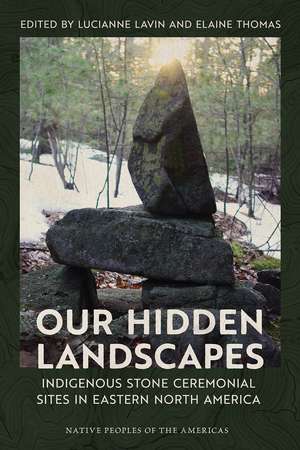Our Hidden Landscapes: Indigenous Stone Ceremonial Sites in Eastern North America: Native Peoples of the Americas
Editat de Lucianne Lavin, Elaine Thomasen Limba Engleză Hardback – 31 oct 2023
This volume introduces readers to eastern North America’s Indigenous ceremonial stone landscapes (CSLs)—sacred sites whose principal identifying characteristics are built stone structures that cluster within specific physical landscapes. Our Hidden Landscapes presents these often unrecognized sites as significant cultural landscapes in need of protection and preservation.
In this book, Native American authors provide perspectives on the cultural meaning and significance of CSLs and their characteristics, while professional archaeologists and anthropologists provide a variety of approaches for better understanding, protecting, and preserving them. The chapters present overwhelming evidence in the form of oral tradition, historic documentation, ethnographies, and archaeological research that these important sites created and used by Indigenous peoples are deserving of protection.
This work enables archaeologists, historians, conservationists, foresters, and members of the general public to recognize these important ritual sites.
Contributors
Nohham Rolf Cachat-Schilling
Robert DeFosses
James Gage
Mary Gage
Doug Harris
Julia A. King
Lucianne Lavin
Johannes (Jannie) H. N. Loubser
Frederick W. Martin
Norman Muller
Charity Moore Norton
Paul A. Robinson
Laurie W. Rush
Scott M. Strickland
Elaine Thomas
Kathleen Patricia Thrane
Matthew Victor Weiss
Preț: 572.85 lei
Preț vechi: 698.60 lei
-18% Nou
Puncte Express: 859
Preț estimativ în valută:
109.65€ • 119.14$ • 92.17£
109.65€ • 119.14$ • 92.17£
Carte indisponibilă temporar
Doresc să fiu notificat când acest titlu va fi disponibil:
Se trimite...
Preluare comenzi: 021 569.72.76
Specificații
ISBN-13: 9780816550876
ISBN-10: 0816550875
Pagini: 384
Ilustrații: 90 b&w illustrations, 36 maps, 6 tables
Dimensiuni: 152 x 229 x 28 mm
Greutate: 0.63 kg
Editura: University of Arizona Press
Colecția University of Arizona Press
Seria Native Peoples of the Americas
ISBN-10: 0816550875
Pagini: 384
Ilustrații: 90 b&w illustrations, 36 maps, 6 tables
Dimensiuni: 152 x 229 x 28 mm
Greutate: 0.63 kg
Editura: University of Arizona Press
Colecția University of Arizona Press
Seria Native Peoples of the Americas
Notă biografică
Lucianne Lavin is an archaeologist, a director emeritus of research and collections at the Institute for American Indian Studies Museum in Connecticut, and the author of Connecticut’s Indigenous Peoples.
Elaine Thomas is a Mohegan tribal member and has worked in the Mohegan Tribal Government for twenty-two years. She works with tribal nations in identifying and preserving ceremonial stone landscapes.
Elaine Thomas is a Mohegan tribal member and has worked in the Mohegan Tribal Government for twenty-two years. She works with tribal nations in identifying and preserving ceremonial stone landscapes.
Recenzii
“The editors have presented a very successful case for the long-term use as well as the historic Native use of ceremonial stone landscapes (CSL). Thirty-three tribes, these authors, and these editors want these landscapes recognized and preserved.”—Cheryl Claassen, Journal of Anthropological Research
“Our Hidden Landscapes offers a mountain of evidence for the indigenous origins of ceremonial stone landscapes. It recognizes the criticisms of skeptics and takes them head on. The extent of evidence displayed throughout the text is compelling, as is the overall argument.”—Yusuf Mansoor, Connecticut History Review
“Our Hidden Landscapes: Indigenous Stone Ceremonial Sites in Eastern North America is a must-read text written by an eclectic group of knowledgeable authors that provide a diverse perspective on the problematic issues surrounding Native American sacred stone structure sites.”—Harry O. Holstein, Stones Bones
“The chapters offer a perspective and opinions on the indigenous cultural landscape scene in eastern North America, one that is seldom (if ever) seen or discussed by conventional archeology. The book is written to widen the view and argue for more research and insights regarding eastern North American stone constructs and indigenous origins.”—Herman E. Bender, President of the Hanwakan Center for Prehistoric Astronomy, Cosmology and Cultural Landscape Studies
“Our Hidden Landscapes offers a mountain of evidence for the indigenous origins of ceremonial stone landscapes. It recognizes the criticisms of skeptics and takes them head on. The extent of evidence displayed throughout the text is compelling, as is the overall argument.”—Yusuf Mansoor, Connecticut History Review
“Our Hidden Landscapes: Indigenous Stone Ceremonial Sites in Eastern North America is a must-read text written by an eclectic group of knowledgeable authors that provide a diverse perspective on the problematic issues surrounding Native American sacred stone structure sites.”—Harry O. Holstein, Stones Bones
“The chapters offer a perspective and opinions on the indigenous cultural landscape scene in eastern North America, one that is seldom (if ever) seen or discussed by conventional archeology. The book is written to widen the view and argue for more research and insights regarding eastern North American stone constructs and indigenous origins.”—Herman E. Bender, President of the Hanwakan Center for Prehistoric Astronomy, Cosmology and Cultural Landscape Studies
Descriere
Our Hidden Landscapes introduces people to eastern North America’s Indigenous ceremonial stone landscapes (CSLs)—sacred sites whose principal identifying characteristics are built stone structures that cluster within specific physical landscapes. This volume presents these often unrecognized sites as significant cultural landscapes in need of protection and preservation. Chapters from Indigenous community members, archaeologists, and anthropologists provide a variety of approaches for better understanding, protecting, and preserving these important sacred spaces.



